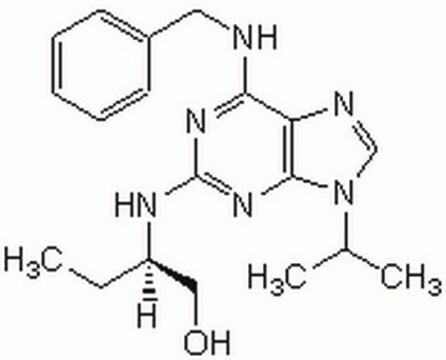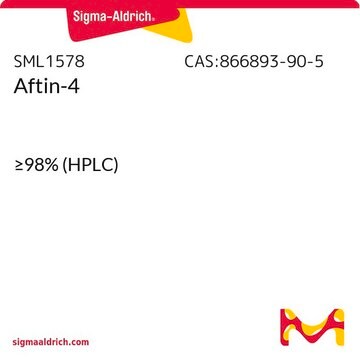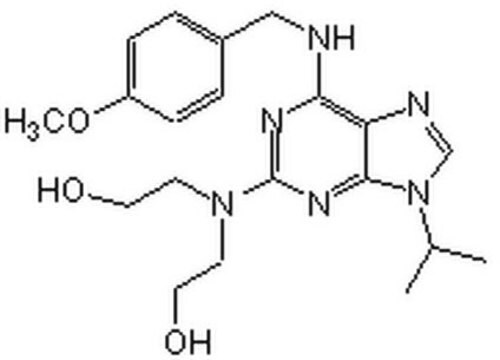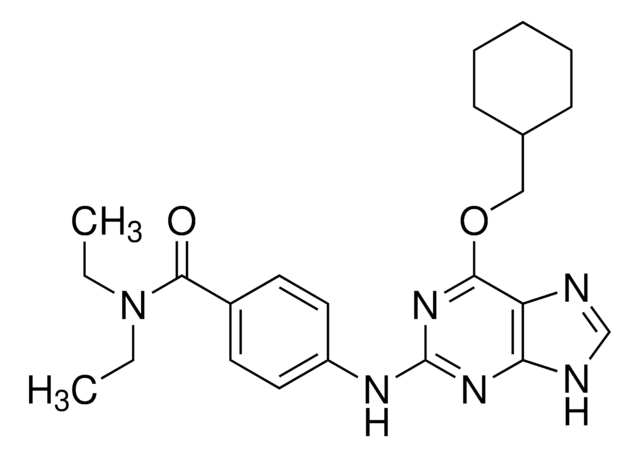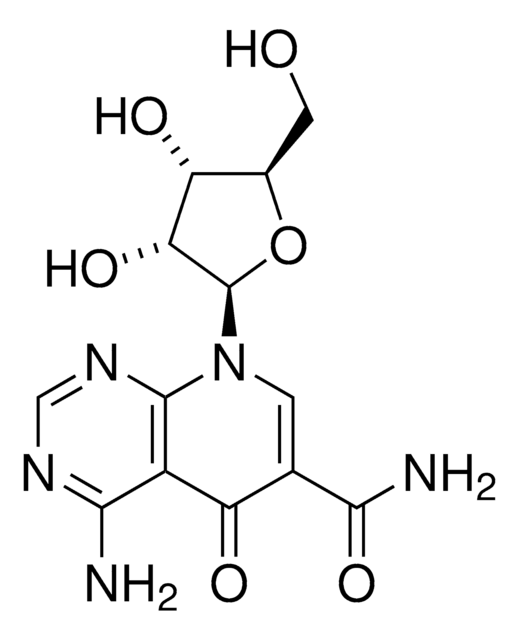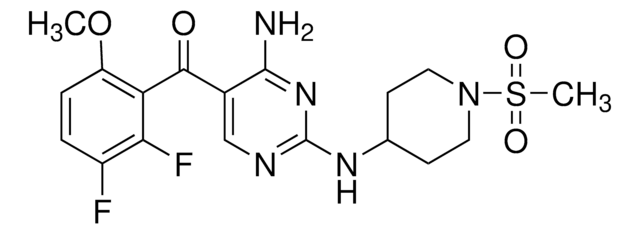R7772
Roscovitine
≥98% (TLC)
Synonym(e):
2-(R)-[[9-(1-Methylethyl)-6-[(phenylmethyl)amino]-9H-purin-2-yl]amino]-1-butanol, 6-(Benzylamino)-2(R)-[[1-(hydroxymethyl)propyl]amino]-9-isopropylpurine
About This Item
Empfohlene Produkte
Biologische Quelle
synthetic (organic)
Assay
≥98% (TLC)
Form
powder
mp (Schmelzpunkt)
106-107 °C
Löslichkeit
chloroform: 50 mg/mL, clear, colorless to light yellow
Lagertemp.
−20°C
SMILES String
CC[C@H](CO)Nc1nc(NCc2ccccc2)c3ncn(C(C)C)c3n1
InChI
1S/C19H26N6O/c1-4-15(11-26)22-19-23-17(20-10-14-8-6-5-7-9-14)16-18(24-19)25(12-21-16)13(2)3/h5-9,12-13,15,26H,4,10-11H2,1-3H3,(H2,20,22,23,24)/t15-/m1/s1
InChIKey
BTIHMVBBUGXLCJ-OAHLLOKOSA-N
Angaben zum Gen
human ... CDK1(983) , CDK2(1017) , CDK5(1020) , CDK7(1022) , CDK9(1025) , CDKN1A(1026) , CDKN1B(1027) , CDKN1C(1028) , CDKN2A(1029) , CDKN2B(1030) , CDKN2C(1031) , CDKN2D(1032) , CDKN3(1033)
mouse ... CDK1(12534)
rat ... CDK1(54237)
Suchen Sie nach ähnlichen Produkten? Aufrufen Leitfaden zum Produktvergleich
Anwendung
- an inhibitor of p34cdc2/cyclin B kinase to preculture porcine oocytes
- as a supplement in TCM199 medium for in vitro prematuration of cumulus-oocyte complexes (COCs) of adult goats
- in astrocyte conditioned media as an inhibitor of cyclin-dependent kinase 5 (CDK5)
- as a CDK2 inhibitor in culture media to treat hESCs
Biochem./physiol. Wirkung
Leistungsmerkmale und Vorteile
Rechtliche Hinweise
Lagerklassenschlüssel
11 - Combustible Solids
WGK
WGK 3
Flammpunkt (°F)
Not applicable
Flammpunkt (°C)
Not applicable
Persönliche Schutzausrüstung
Eyeshields, Gloves, type N95 (US)
Analysenzertifikate (COA)
Suchen Sie nach Analysenzertifikate (COA), indem Sie die Lot-/Chargennummer des Produkts eingeben. Lot- und Chargennummern sind auf dem Produktetikett hinter den Wörtern ‘Lot’ oder ‘Batch’ (Lot oder Charge) zu finden.
Besitzen Sie dieses Produkt bereits?
In der Dokumentenbibliothek finden Sie die Dokumentation zu den Produkten, die Sie kürzlich erworben haben.
Kunden haben sich ebenfalls angesehen
Artikel
Cell cycle phases (G1, S, G2, M) regulate cell growth, DNA replication, and division in proliferating cells.
Apoptosis regulation involves multiple pathways and molecules for cellular homeostasis.
Unser Team von Wissenschaftlern verfügt über Erfahrung in allen Forschungsbereichen einschließlich Life Science, Materialwissenschaften, chemischer Synthese, Chromatographie, Analytik und vielen mehr..
Setzen Sie sich mit dem technischen Dienst in Verbindung.